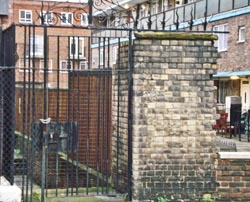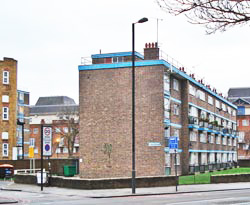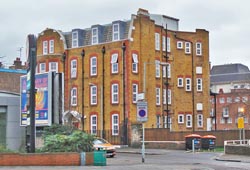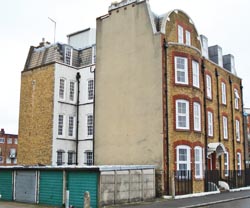Royal Chest Hospital
City Road, EC1 7TJ
Medical
dates:
Medical
character:
Specialist
The Infirmary for Asthma,
Consumption and Other Pulmonary Diseases opened in 1814 with 8 beds in
a 12-roomed house at 36 Union
Street (later renamed Brushfield Street) in Spitalfields. It had
been established by Dr Isaac Buxton (1775-1825) of the London Hospital,
and was
supported by the Duke of Kent and the Duke of Sussex. It
was reputedly the first hospital specialising in diseases of the
chest in
the world.
The building soon became inadequate and, in 1832, the Infirmary moved to 13, then 10 Artillery Street (later renamed Artillery Lane), also in Spitalfields. However, because of a lack of funding, no in-patients could be admitted.
In 1848 Queen Victoria became a patroness and the Infirmary was renamed the Royal Infirmary for Asthma, Consumption and Other Diseases of the Lungs. It moved to temporary accommodation at 4 Dean Street (now Sun Street), Finsbury Square, until 1850, when it moved to a house in City Road belonging to St Bartholomew's Hospital, where it re-opened for in-patients as the Royal Infirmary for Asthma, Consumption and Other Diseases of the Chest.
In 1859 its name was shortened to the Royal Infirmary for Diseases of the Chest.
In 1862 the house was pulled down and a purpose-built building erected. In the same year an Out-Patients Department was added.
In 1867 it became the Royal Hospital for Diseases of the Chest. Further additions were made in 1876 and the freehold was acquired from St Bartholomew's in 1880. A new ward block was added in 1886 and a Nurses' Home in 1900.
In 1912 it established a department for the prevention of consumption (TB), a disease prevalent at the time.
During WW1 the Hospital was affiliated to the City of London Military Hospital in Clifden Road, with 111 beds reserved for sick and wounded servicemen.
In 1919 its name changed again and it became the Royal Chest Hospital.
Because of a lack of space and financial difficulties, in 1921 it amalgamated with the Royal Northern Hospital , which paid its debts. Its in-patients had a special wing at the Holloway Road site.
It had been the intention to move the Royal Chest Hospital patients to a separate block when the Royal Northern Hospital was rebuilt, but the outbreak of WW2 scuppered this plan.
In 1941 the building in City Road was badly damaged by bombing; the whole of the front portion was destroyed and 85 beds lost. The Out-Patients Department continued to stay open, but the wards were closed.
In 1948 the Hospital became part of the NHS. The war damage was never repaired; it closed in 1954 and was subsequently demolished.
Present status (January 2008)
The building soon became inadequate and, in 1832, the Infirmary moved to 13, then 10 Artillery Street (later renamed Artillery Lane), also in Spitalfields. However, because of a lack of funding, no in-patients could be admitted.
In 1848 Queen Victoria became a patroness and the Infirmary was renamed the Royal Infirmary for Asthma, Consumption and Other Diseases of the Lungs. It moved to temporary accommodation at 4 Dean Street (now Sun Street), Finsbury Square, until 1850, when it moved to a house in City Road belonging to St Bartholomew's Hospital, where it re-opened for in-patients as the Royal Infirmary for Asthma, Consumption and Other Diseases of the Chest.
In 1859 its name was shortened to the Royal Infirmary for Diseases of the Chest.
In 1862 the house was pulled down and a purpose-built building erected. In the same year an Out-Patients Department was added.
In 1867 it became the Royal Hospital for Diseases of the Chest. Further additions were made in 1876 and the freehold was acquired from St Bartholomew's in 1880. A new ward block was added in 1886 and a Nurses' Home in 1900.
In 1912 it established a department for the prevention of consumption (TB), a disease prevalent at the time.
During WW1 the Hospital was affiliated to the City of London Military Hospital in Clifden Road, with 111 beds reserved for sick and wounded servicemen.
In 1919 its name changed again and it became the Royal Chest Hospital.
Because of a lack of space and financial difficulties, in 1921 it amalgamated with the Royal Northern Hospital , which paid its debts. Its in-patients had a special wing at the Holloway Road site.
It had been the intention to move the Royal Chest Hospital patients to a separate block when the Royal Northern Hospital was rebuilt, but the outbreak of WW2 scuppered this plan.
In 1941 the building in City Road was badly damaged by bombing; the whole of the front portion was destroyed and 85 beds lost. The Out-Patients Department continued to stay open, but the wards were closed.
In 1948 the Hospital became part of the NHS. The war damage was never repaired; it closed in 1954 and was subsequently demolished.
Present status (January 2008)
The site has been redeveloped and now contains Buxton Court. Thoresby House - the former Nurses' Home - is now owned by Arcadia University Center for Education Abroad, Pennsylvania, and is a hostel for American students studying in London.

All that remains of the Hospital is part of its outer wall to the right of the former Nurses' Home.

The Hospital site now contains Buxton Court, named after the founder of the Hospital. Part of the Nurses' Home is seen on the extreme left of the image.

The former Nurses' Home in Thoresby Street.

The eastern elevation of the Nurses' Home.
(Author unstated) 1917 List of the various hospitals treating military cases in the United Kingdom. London, H.M.S.O.
(Author unstated) 1921 The Hospital World. British Journal of Nursing, 1st October, 211.
Black N 2006 Walking London's Medical History. London, Royal Society of Medicine Press.
Schuster NH 1953 The Royal Chest Hospital. British Medical Journal 2 (8481), 882-883.
www.aim25.ac.uk
www.british-history.ac.uk
Return to home page